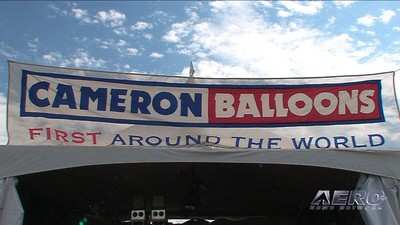AD 2022-01-06 Immediately Requires Either Replacing The QSO Flange Adapter Or Inspecting The Fuel Cylinder For Leakage
The FAA is adopting a new airworthiness directive (AD) for certain Cameron Balloons Ltd. (Cameron) fuel cylinders installed on hot air balloons.

This AD results from mandatory continuing airworthiness information (MCAI) originated by an aviation authority of another country to identify and correct an unsafe condition on an aviation product. The MCAI identifies the unsafe condition as quick shut-off (QSO) flanged adaptors manufactured with non-conforming (undersized) threads. This AD immediately requires either replacing the QSO flange adapter or inspecting the fuel cylinder for leakage and taking corrective action, and replacing the QSO flange adapter within 4 months. The FAA is issuing this AD to address the unsafe condition on these products. This AD is effective January 18, 2022.
Supplementary Information: The Civil Aviation Authority (CAA), which is the airworthiness authority for the United Kingdom, has issued CAA AD G-2021-0014R1-E, dated December 10, 2021 (referred to after this as “the MCAI”), to address an unsafe condition for certain Cameron fuel cylinders.
The MCAI states:
- Certain Cameron Hot Air Balloon fuel cylinders are supplied with liquid offtakes that consist of a quarter turn ball valve mounted on a flanged adaptor ([part number] P/N CB437, see [CAA AD] figure 1). Two recent batches of these adaptors have been manufactured with non-conforming (undersize) threads.
- In certain cases, when the minimum sized adaptors are combined with cylinder bosses at maximum tolerance dimension and assembled to fuel cylinders, the thread can impinge (“bottom out”) on the cylinder boss. Although the required tightening torque value can be achieved at installation, the torque required to unscrew the flange could be below the minimum value. In extreme cases the adaptor may be unscrewed by hand.
- This condition, if not detected and corrected, could result in an uncontrolled release of liquid propane which in turn could result in a fire hazard that could damage the balloon and its envelope, ultimately leading to a forced emergency landing, during which balloon occupants and persons on the ground could be injured.
- To address this potential unsafe condition, Cameron Balloons Ltd. issued the Service Bulletin to provide instructions for the removal from service of the affected parts.
- For the reasons described above, this [CAA] AD retains the requirements of CAA Emergency AD G-2021-0010-E dated 01 October 2021, which required a one-time inspection of each affected fuel cylinder for leakage around the threaded joint between the QSO valve adaptor flange and the cylinder boss and, depending on findings, removal from service of the affected fuel cylinder. The AD also required modification of each fuel cylinder by replacement of the affected part with a serviceable part.
- Since AD G-2021-0010-E was issued, additional applicability information has been released by the manufacturer, Cameron Balloons Ltd. Additional serial number applicability for CB2902 Cylinders has been identified and added to the list of affected parts. (See [CAA AD] appendix 1).
- For the reason described above AD 2021-0010-E, was superseded by AD G-2021-0014-E which expands the list of affected parts.
- Since the issue of AD G-2021-0014-E additional information pertaining to the means of visual identification of the affected parts has been released by the manufacturer, Cameron Balloons Ltd. It was also found that that the replacement part specified in the previous [emergency airworthiness directives] EADs, Part No. CB437 ‘Issue G' did
- not go into production and instead ‘Issue H' was produced.
- For the reasons described above this [CAA] AD has been revised to include additional information in the applicability, the inclusion of photos ([CAA AD] figures 2, 3 and 4) and to reference the correct replacement part number (updated drawing issue).
This revised [CAA] AD also introduces editorial changes not affecting the requirements. You may examine the MCAI in the AD docket at https://www.regulations.gov by searching for and locating Docket No. FAA-2021-1171.
Cameron identified fuel cylinder P/Ns CB2901, CB2902, and CB2903 that had the nonconforming QSO flange adapter P/N CB437 Issue F installed at manufacture. However, the following additional fuel cylinders that were not fitted with flange adapter P/N CB437 Issue F at manufacture may have been later retrofitted with P/N CB437 Issue F: Fuel cylinder P/Ns CB2901, CB2902, and CB2903; stainless steel fuel cylinder P/Ns CB426, CB497, CB599, CB959, CB2088, V20, V30, and V40; titanium fuel cylinder P/Ns CB2380, CB2383, CB2385, CB2387, and T30 (CY-050-A-001); and “Worthington” aluminum fuel cylinder P/N CB250.
The unsafe flange adapter has “CB437” machine-engraved on the part. Flange adapters with “CB437” hand-stamped on the part or machine-engraved with Issue H (“CB437/H”) or later issue are not subject to the unsafe condition.
 Citation Operators Get Another Flight Data Connection for QA
Citation Operators Get Another Flight Data Connection for QA ANN's Daily Aero-Linx (06.01.25)
ANN's Daily Aero-Linx (06.01.25) NTSB Final Report: Bellanca 8GCBC
NTSB Final Report: Bellanca 8GCBC Aero-News: Quote of the Day (06.01.25)
Aero-News: Quote of the Day (06.01.25) Classic Aero-TV: High-Speed Match-up - Venom and GE Rebirth A Legend
Classic Aero-TV: High-Speed Match-up - Venom and GE Rebirth A Legend



